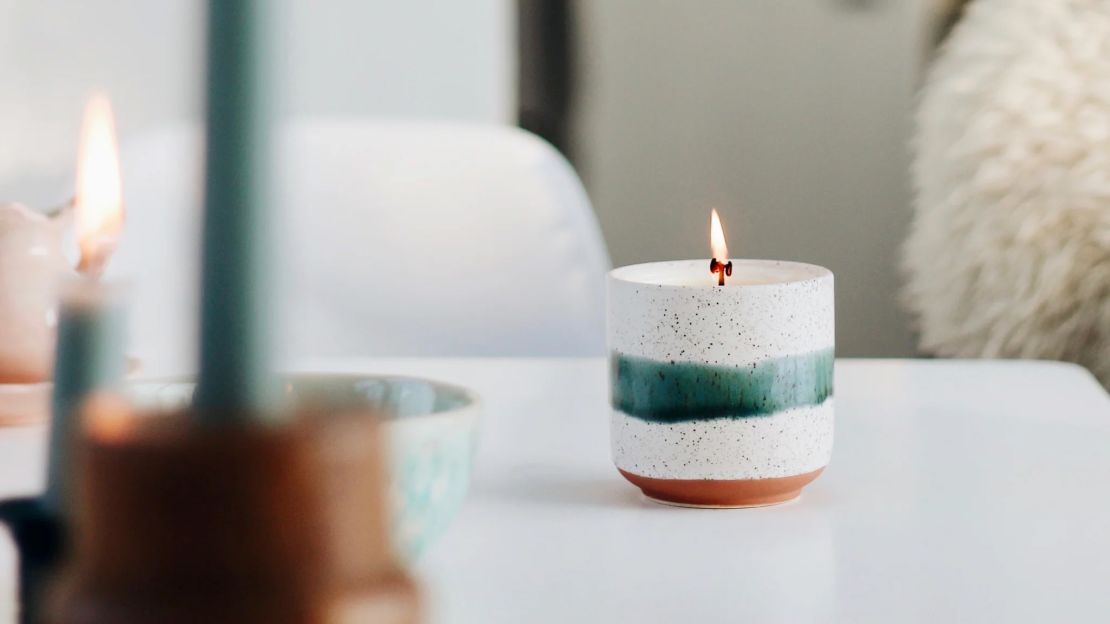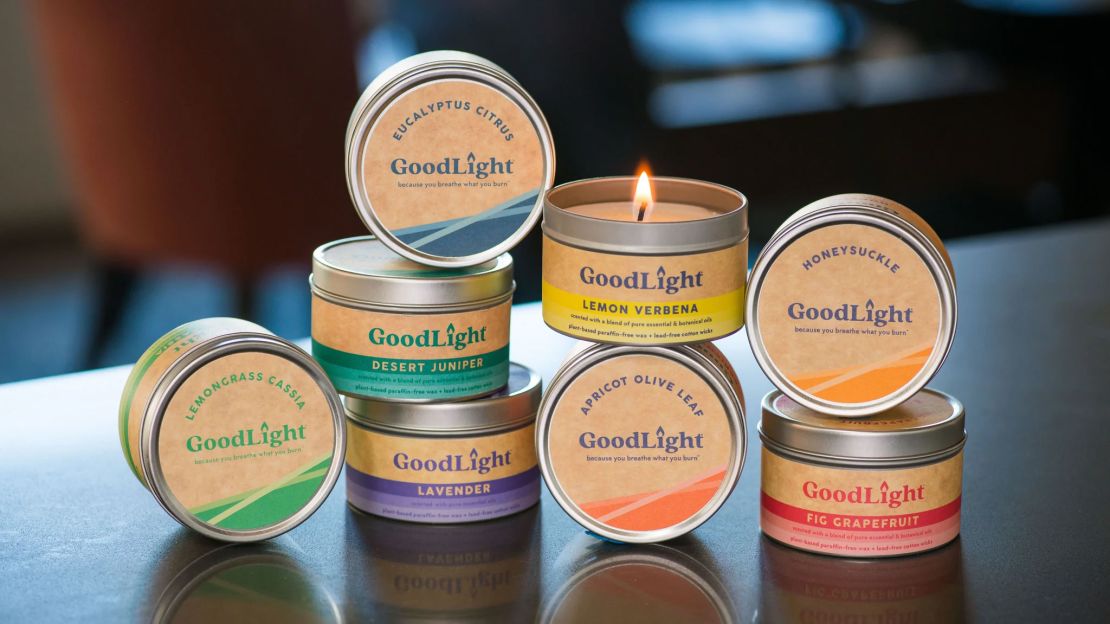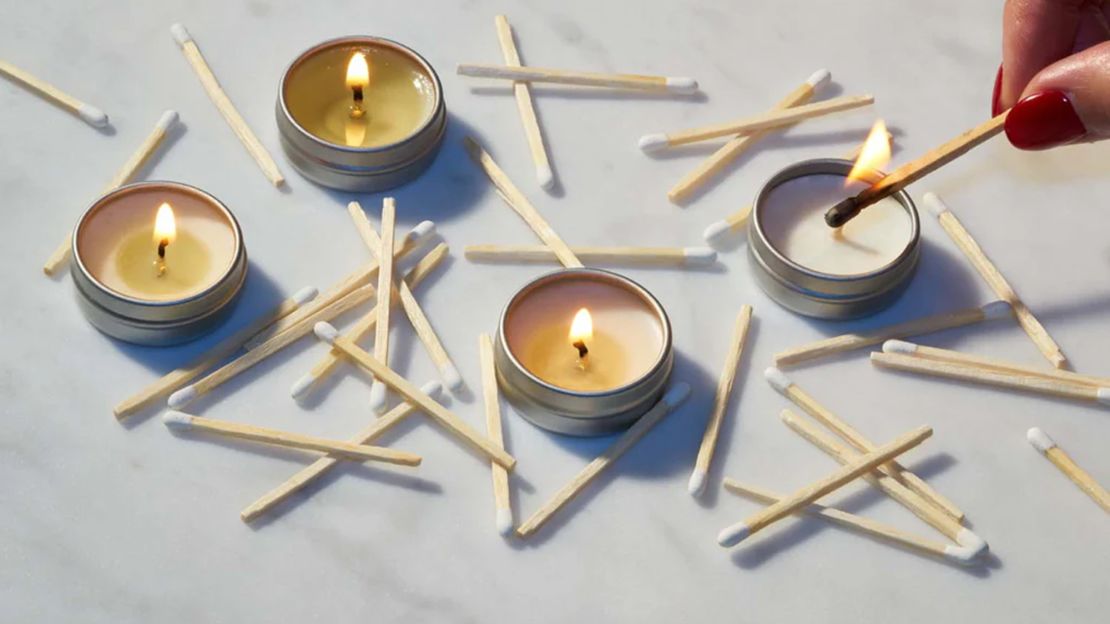There’s nothing quite like a good scented candle. Whether they’re helping you cozy up in fall or brightening up your home after a deep spring cleaning session, candles are a fantastic way to set the mood. But are they eco-friendly? As is the case with any product you buy for your home, not all candles are created equal, and some leave a larger carbon footprint than others. Do a cursory search on whether candles are eco-friendly, and you’ll find plenty of discourse about the potential human health impacts of burning scented candles — much of which is still debated and requires further research. As far as sustainability goes, there’s also a fair amount of gray area (and greenwashing), but many experts agree on certain factors that make candles not-so-eco-friendly — and what you can look for when searching for more sustainable options.
What’s the problem with candles?
The wax
It all starts with the wax — most of which, when it comes to candles, isn’t produced by buzzing bees. “Most conventional candles stocked on shelves today are made of paraffin wax that is derived from petroleum,” says Lindsay Christinee, founder of The Wellness Feed and a Sierra Club delegate. “Basically, it’s the by-product of gasoline, which makes it inexpensive, but probably not something that you want to have burning in your house.”

Indeed, some research has also shown that burning paraffin wax candles can create more indoor air pollution when burned than alternatives like palm stearin. Many experts point specifically to the volatile organic compounds (VOCs) released, along with visible soot. While the increase in air pollution from burning paraffin candles may be negligible, that doesn’t change the fact that paraffin is made from fossil fuels, which makes it inherently not eco-friendly.
Many people also avoid beeswax, which, as Jessian Choy, the journalist behind Sierra Magazine’s “Ask Ms. Green” column, points out, isn’t vegan. It’s also best to avoid candles with any other additions, like color from potentially harmful dyes, crystals and glitter, the latter of which, Choy says, “are most likely [made] from polluting fossil fuels.”
The fragrance
The allure of candles — especially seasonal ones — is usually the scent. But when it comes to eco-friendly candles, it’s important to consider how that jar of wax came to emit the smell of pumpkin spice or ocean breeze. Manufacturers can add scents in all sorts of ways, from pure essential oils to synthetic chemicals. And even more frustrating, it’s rare that brands disclose exactly what their candle fragrances contain on the labels. “To date, there aren’t regulations around companies listing scent ingredients,” Christinee says. “Consumers are left with the ubiquitous ‘fragrance’ ingredient, which can mean any of the thousands of chemicals available on the market.”
Like wax, synthetic fragrances are typically derived from fossil fuels?and contain any number of potentially harmful additional chemicals, whereas essential oils come from botanicals.
The containers
At first glance, you’d think most scented candle vessels — commonly glass and metal — are as sustainable as it gets. But, alas, it’s not so simple once you add wax and oil and burn countless small fires within those vessels. “Glass candle jars are usually not recyclable because of what is left over in them: the remaining wax and the wick,” says Hua Liu, vice president of research and development at TerraCycle. “The wax will ruin the recycling process. If people put uncleaned glass candle jars into the general recycling bin, the jars will be rejected and go to landfill. The same would apply to all other types of candle containers where the containers themselves are made of recyclable materials, including those tin ones.”

As with much recycling, it’s an uphill battle. “There are certain municipalities that would accept cleaned glass or tin candle jars only when the consumers completely remove all the content, including the wax, the wick and sometimes the stickers, clean the jars and dry them thoroughly,” Liu says. “Consumers can check with their municipality to see if this is allowed where they live.”
What are the more eco-friendly options?
There’s no lack of alternatives to paraffin wax, though determining the “best” option isn’t exactly an easy feat. “The best ingredients for candles from a human’s point of view are soy, beeswax and coconut,” says Diana Verde Nieto, co-CEO of Positive Luxury, a company focused on increasing and assessing sustainability in the luxury industry. “If you think about the cost to nature, beeswax can harm bees, and soy is not a great industry, as soy is often farmed as a monocrop and is not [always] organic.” Indeed, while soy wax is a popular renewable paraffin alternative, some manufacturers and consumers are steering clear because of soybean farming’s environmental impacts, like extensive deforestation, water pollution and genetically modified crops. That said, it’s worth knowing according to the World Wildlife Fund, nearly 80% of the world’s soybean crop is used for livestock feed —?not candles.
If you buy soy candles, look for organic and responsibly sourced soy wax — and, as with any sustainable products, the more transparency, the better. “Ideally, we should know where the soy comes from and what agricultural farming methods they use,” Nieto says.
Beware of blends while you’re at it. “Watch out for candles labeled ‘Soy Wax Blend’ because a candle only needs to be 51% soy wax to be labeled that way,” says Kate De Palma, founder and CEO of Scented Designs Candle Co. Or, you can avoid soy wax altogether by shopping for candles made with coconut or grapeseed oil, which experts say are clean-burning and usually put less of a strain on the environment.

As for fragrance, the reality is that, from a sustainability standpoint, “the best candles are scent-free,” Nieto says, alluding to the environmental pitfalls of both synthetic fragrances and essential oils. Nearly every expert we spoke with for this article recommends botanical essential oil-scented candles over synthetic options. That said, it’s worth at least knowing that creating just 1 pound of essential oil requires hundreds —?sometimes thousands —?of pounds of plant matter, and the farming and extraction processes can be incredibly resource intensive, according to Earth Island Journal.
If you do opt for unscented candles, keep in mind that products labeled “unscented” or “scent-free” may still contain a small amount of fragrance, as Choy points out. If you really want zero fragrance, look for labels that explicitly state the candle is “fragrance-free.” Of course, for most people, going scent-free “defeats the purpose of buying candles,” Nieto says, but “life is full of trade-offs and balances.”
As Liu says, most glass and metal candle containers can be recycled, but only if you thoroughly wash them so no wax or oils remain. You can also look for refillable candles (or wax kits that you can use in containers you already own). And if you can’t reuse or fully clean out a candle jar when you’re done, try giving it away through a local Buy Nothing group (chances are, you’ll find people who enjoy candle-making) or look for programs like TerraCycle’s Newell Brands Home Fragrance Free Recycling Program that do the cleaning and recycling for you (for certain brands and products).
Ultimately, the concept of an “eco-friendly” candle isn’t so cut-and-dried — as is the case with almost any “sustainable” product. You may come across certain labels or certifications that help clear things up, like USDA Organic wax or oil,?the Green Seal or Nieto’s Butterfly Mark for luxury items.
If you experience a bit of sticker shock when shopping for sustainable candles, remember that product costs typically correlate to values. “Beware of low prices that are too good to be true,” Christinee says. “Much like the low prices of fast fashion that are made possible thanks to low wages and plastic-based material like polyester, candles made from fossil fuels will also be cheaper.” Meanwhile, “candles made from beeswax or soy and scented with essential oils will cost more because these raw materials cost more. So, you won’t necessarily be able to purchase five of your favorite $10 candles.? You might only be able to purchase one $40 candle. But, what you’re getting in return is a product that isn’t sourced from fossil fuels and won’t release VOCs or carcinogens when lit. I’d call that a win.”
Best eco-friendly candles
With this option, you can combine two favorites: cozy candles and sustainable gardening. “Hyggelight creates vegan candles that come in reusable ceramic plant pots, which include wildflower seed paper labels,” says Kathryn Kellogg, author of “101 Ways to Go Zero Waste.” “Once the candle is gone, you can just use the pot for growing plants.” Plus, Kellogg adds, “the candle itself is made from 100% pure soy wax that’s free of additives, colorants, phthalates and toxins. It also features a lead-free cotton wick and is hand-poured in small batches in Ohio.”?
Sonia Madaan, founder of Earth Eclipse, is a big fan of Keap’s Wood Cabin scented candle, which she notes is “made from a sustainable coconut wax blend and scented with essential oils.” Indeed, Keap prioritizes regenerative practices, from the sourcing of its wax and fragrances to its compostable and recyclable packaging and easily reusable jars.
Kellogg is another fan of Keap’s zero-waste, ethically made candles. “You can repurpose the candle holder for a drinking glass,” she says. “The packaging is zero waste too: They use both mushroom packaging and 100% recycled newspaper-based molded pulp for their subscription shipments. Even their shipping label is home compostable too.” Kellogg recommends the brand’s candle subscription, which you can customize by scent and frequency.?
Isaias Hernandez, the environmental media creative behind @QueerBrownVegan, counts GoodLight Candles — which boast recyclable and reusable aluminum tins, paraffin-free wax, pure cotton wicks and chemical-free fragrances — among his favorites. Plus, GoodLight has “an unscented option for people not wanting a specific aroma,” Hernandez says.?
Hernandez also recommends this multitasking candle that also works as a massage oil and body balm once the wax melts. “It's vegan, cruelty-free, non-GMO and made locally in Ohio,” he says. “They also offer a variety of different scents.” Indeed, if you don’t need sore muscle relief, you can opt for one of the brand’s other soothing scents, a Romantic Spirit bath and body oil or a multiuse bug-repellant formula.?
Edgewater Candles is a small, Chicago-based business that’s been crafting deliciously scented candles since 2016. The minimalist candles —?poured in clear mason jars with simple, round labels —?are all made in Illinois, with Midwestern-grown soy wax, cotton wicks and fragrances that are a blend of essential and (phthalate-free) synthetic oils. Local customers can take advantage of Edgewater Candles’ take-back program: Bring the empty jar back to the Chicago store and get 10% off your new purchase that day.?
If you already have more empty candle containers than you know what to do with, try a kit from Siblings —?it’s just the wax (and the wick), along with easy-to-follow instructions on how to melt it down and turn it into your new favorite candle. No new vessel to add to your growing collection, and even the bag the wax comes in is compostable. The wax itself is a blend of coconut, soy and beeswax, as well as apricot oil, and the scents are made from a mix of essential and “nontoxic fragrance” oils free of “harsh chemicals,” per the company.?
Madaan’s other favorite is made in Brooklyn with 100% soy wax from American-grown soybeans and cotton wicks. It’s free of petroleum and ships plastic-free. Per the website, the fragrance is “infused with essential oils,” though it does contain some synthetic ingredients as well.?
Enlighten Candles are delightfully minimalist, with a clean, simple design that’s also reflected in the production. All of Enlighten’s candles are made with 100% soy wax and cotton wicks and are free of phthalates, petroleum, dyes and other additives. They’re made in the US, hand-poured in small batches in Arizona into recyclable tins and glass tumblers.?
“I love this candle; I’m looking at it on my desk as we speak,” says Alexandra Shadrow, an Al Gore climate leader, member of the Environmental Media Association board and founder of Thriftspired on Instagram. “The candle is vegan, sustainably packaged, non-GMO and paraben-free. It is one of the strongest candles I've ever had, capable of filling a huge space in just a small package.”?
The biggest roadblock to reusing or recycling any candle jar tends to be the process of removing the excess wax that didn’t burn. It’s doable, especially if you use tricks like freezing the candle for a few hours first, but if you still struggle — or just don’t want to go through the hassle —?Arbor Made’s Refillable Candle Jar might just be the perfect solution. The jar has a flexible base that allows you to push up on and pop out the wax; if you want a turnkey refill solution, the brand has that too. The zero-waste candle refills are made with 100% soy wax, organic cotton wicks and nontoxic fragrance blends — all of which are US sourced. Arbor Made is a member of 1% for the Planet, and each of its refill scents corresponds to a unique environmental nonprofit, such as Green Forests Work for Cinnamon Swoon or even the Clean Air Task Force for the unscented refill.?
Shadrow also recommends Prosperity Candle, a certified B Corp that sells handmade coconut-and-soy-wax-blend candles scented with essential oils and cotton wicks. The company started in Iraq as a social enterprise to empower women widows of war, but today, the candles are mostly made in the US by women artisans who lived as refugees for years and who now earn a living wage, per the website, which breaks down how the money from each candle sale is distributed.?
Forrest McCall, co-owner of home improvement site Mama Needs a Project, loves Sanari Candle’s small-batch candles handcrafted with vegan coconut and soy wax. They “feature large wicks made entirely of unbleached cotton and are made with certified organic essential oils, cinnamon bark, cloves and vanilla beans,” he says, noting that the wax, wicks and oils are all responsibly sourced. Plus, “to help you decrease waste, they meticulously hand-pour their fragrant ecological candles into a reusable wine glass.”?
It’s clear Meno Home takes candle sustainability seriously. Not only are its candles made with 100% US-grown soy wax (sourced within 500 miles of production, minimizing the carbon footprint and allowing the company to “aggressively and accurately trace and maintain traceability of [its] raw ingredients,” founder of Meno Home Jerri Hobdy says), cotton wicks and essential oil-derived fragrances (with a full, two-page document of chemicals “guaranteed to never be included in our fragrances” available upon request), but they’re also free of stickers, making it easier to reuse or recycle the jars. And all of the packaging, from the seed paper dust cover (plant it in your pollinator garden) to the glue-free recycled cardboard shipping boxes, is recyclable or compostable.?
All of the candles from De Palma’s company, Scented Designs, are hand-poured in California in small batches with US-grown soy wax and essential oil-infused fragrances, packed in plastic-free packaging and shipped with biodegradable peanuts and other reused and recyclable materials — but the mug and teacup collection adds an additional layer of sustainability. “Our line of repurposed mug candles is created using locally sourced mugs to give new life to old mugs, which can then be washed out and reused again after the candle is burned,” De Palma says. Given the premise, the actual available mug and cup designs vary, but hey —?that’s part of the fun.?



































